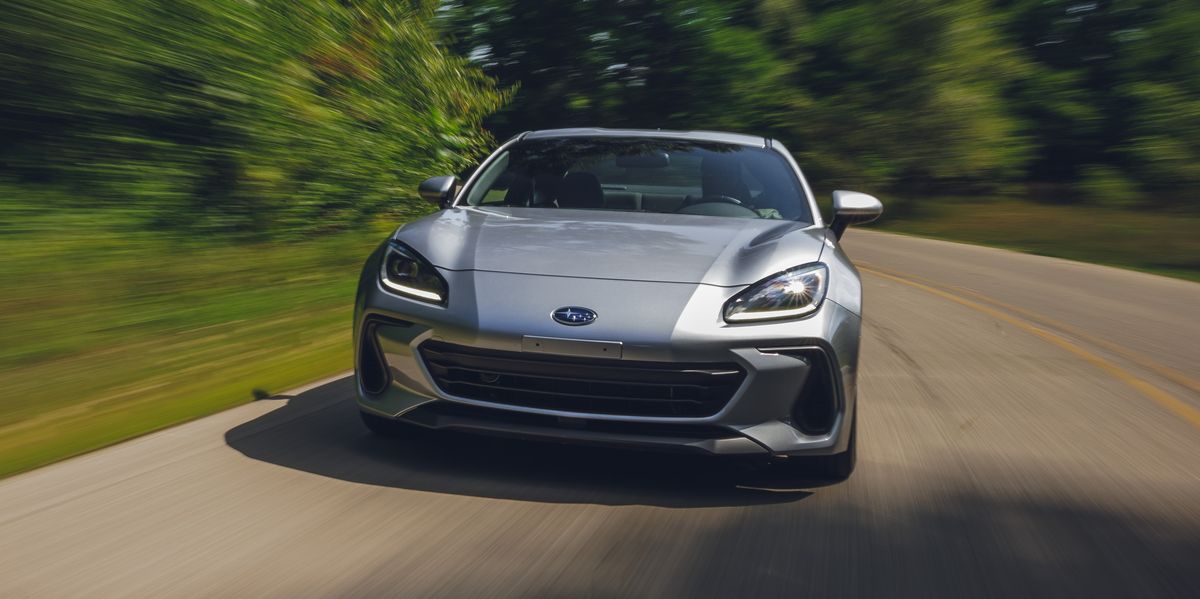Tested: 2022 Subaru BRZ Automatic Makes Fun Easy

Affordable sports cars are a rarity these days. So the redesigned 2022 Subaru BRZ—and its twin, the Toyota GR86—are worth celebrating because they offer a fun-loving demeanor for less than $29,000. And that’s despite a thorough redesign that improved performance and livability; we also celebrated both cars with a 10Best award this year.
The Subie‘s price puts it within reach of young drivers who comprise the next generation of driving enthusiasts. We—and Subaru—need those Gen Z buyers on board with cars like this, or these crisp-handling two-door toys are doomed. So perhaps that’s why, like the GR86 and the similarly accessible Mazda MX-5 Miata, the BRZ is offered with an optional six-speed automatic. With a slushbox, these tiny titans of performance can serve as a sort of gateway drug to sports cars. But is the automatic in a BRZ a total buzzkill?
HIGHS: Prompt throttle response, playful road manners, comes with driver-assistance tech.
While it’s true that the six-speed manual transmission unlocks the BRZ’s maximum performance potential, the six-speed automatic still knows how to have a good time. Throttle response is quick, and torque is plentiful enough to briefly chirp the rear tires, which makes the BRZ feel eager. Shifts are somewhat slow when called up via the steering-wheel paddles, so it’s best to let the gearbox do the work. Punch the throttle and the transmission obliges with a downshift, and the engine sings.
Our base-level Premium test car hit 60 mph in 6.3 seconds and set a quarter-mile time of 14.8 seconds at 97 mph. With the manual transmission, a BRZ Limited we tested managed a 60-mph run of just 5.4 seconds and sailed through the quarter-mile in 13.9 seconds at 101 mph.
Unsurprisingly, this BRZ’s performance aligns closely with that of the GR86 automatic, but the two cars weren’t an exact match. The Toyota hit 60 mph 0.2 second ahead of the Subaru and finished the quarter-mile 0.1 second quicker, although it had the same 97-mph trap speed. The Toyota was just one pound shy of the Subaru’s 2863-pound curb weight, so the difference here likely comes down to tires. Both wore summer rubber, but while the Toyota came with a set of Michelin Pilot Sport 4 tires, the Subaru wore Michelin Primacy HPs. On the BRZ, the Sport 4s are relegated to the more expensive Limited model.
Braking distances from 70 mph of 167 feet for the Subaru and 153 feet for the Toyota highlight the difference between the Michelins. Cornering grip differed as well, with the Subaru losing grip at 0.89 g on our 300-foot skidpad while the Toyota managed to hang on until 0.95 g. The test results don’t mean there’s a discernible difference between the Subie and the Toyota in road manners, though. The automatic BRZ still delivers a raucous good time on a twisty road, and braking performance is confidence inspiring in its consistency.
We’ll concede that without the welcome distraction of manual shifting, we were more aware of the BRZ’s shortcomings. The plasticky and drab interior materials don’t exactly impress given the car’s $30,590 price tag, and the infotainment interface looks and feels state of the art—for 2010. That may not help endear it to digital natives, which is a shame, but perhaps Subaru will remedy that with a larger display and a prettier interface.
LOWS: Not as quick as the manual, basic infotainment, standard tires lack grip.
One advantage of opting for the automatic is that you get Subaru’s EyeSight driver-assistance bundle, which is not available with the stick shift. The package includes automatic high-beam headlamps, automated emergency braking, lane-departure warning, and adaptive cruise control. It all works fine and is a convenience that will undoubtedly make living with the BRZ a little easier, although these types of driver assists are not high on our priority list when it comes to sports cars.
As such, we’d still choose the stick—and we’d also want the upgraded tires that come with the Limited. But it’s nice to know that the automatic retains the BRZ’s fun-to-drive nature even if it saps some performance. Giving the BRZ (and the GR86) the broadest possible appeal hopefully will help both models stick around, and this two-pedal version could provide an on-ramp into our hobby for those next-generation drivers who haven’t learned to row a gearbox for themselves—yet.
Specifications
Specifications
2022 Subaru BRZ Premium Automatic
Vehicle Type: front-engine, rear-wheel-drive, 2+2-passenger, 2-door coupe
PRICE
Base/As Tested: $30,590/$30,590
Options: none
ENGINE
DOHC 16-valve flat-4, aluminum block heads, port and direct fuel injection
Displacement: 146 in3, 2387 cm3
Power: 228 hp @ 7000 rpm
Torque: 184 lb-ft @ 3700 rpm
TRANSMISSION
6-speed automatic
CHASSIS
Suspension, F/R: struts/multilink
Brakes, F/R: 11.6-in vented disc/11.4-in vented disc
Tires: Michelin Primacy HP
215/45R-17 87W
DIMENSIONS
Wheelbase: 101.4 in
Length: 167.9 in
Width: 69.9 in
Height: 51.6 in
Passenger Volume: 78 ft3
Trunk Volume: 6 ft3
Curb Weight: 2863 lb
C/D TEST RESULTS
60 mph: 6.3 sec
1/4-Mile: 14.8 sec @ 97 mph
100 mph: 15.8 sec
130 mph: 30.8 sec
Results above omit 1-ft rollout of 0.3 sec.
Rolling Start, 5–60 mph: 6.5 sec
Top Gear, 30–50 mph: 3.3 sec
Top Gear, 50–70 mph: 4.0 sec
Top Speed (redline ltd): 135 mph
Braking, 70–0 mph: 167 ft
Braking, 100–0 mph: 349 ft
Roadholding, 300-ft Skidpad: 0.89 g
C/D FUEL ECONOMY
Observed: 21 mpg
75-mph Highway Driving: 37 mpg
75-mph Highway Range: 480 mi
EPA FUEL ECONOMY
Combined/City/Highway: 25/21/30 mpg
C/D TESTING EXPLAINED
A car-lover’s community for ultimate access & unrivaled experiences. JOIN NOW

This content is imported from OpenWeb. You may be able to find the same content in another format, or you may be able to find more information, at their web site.



